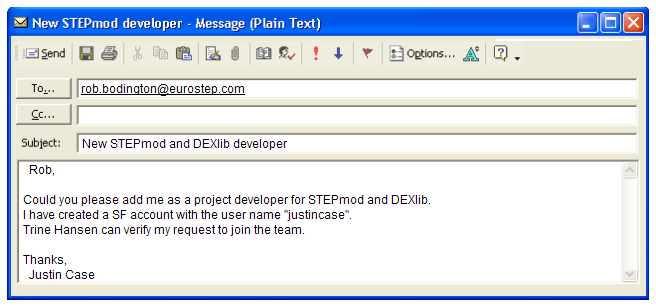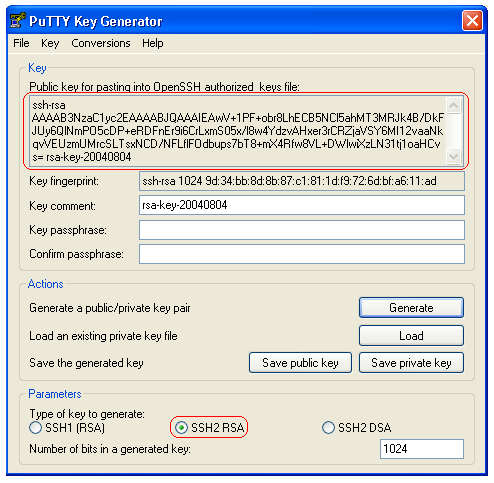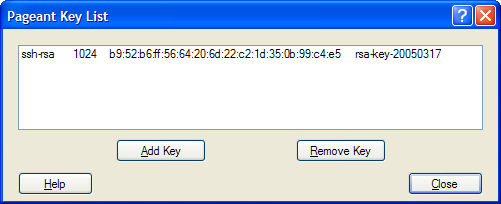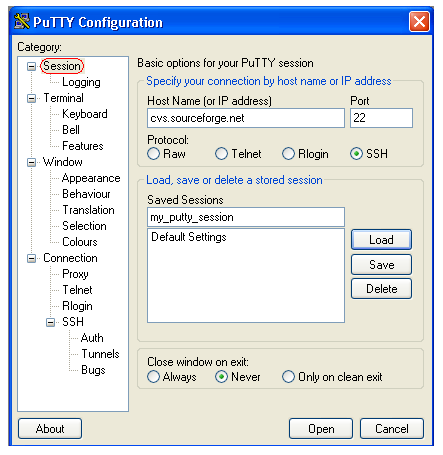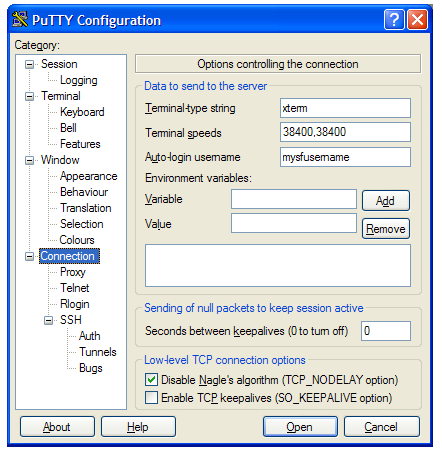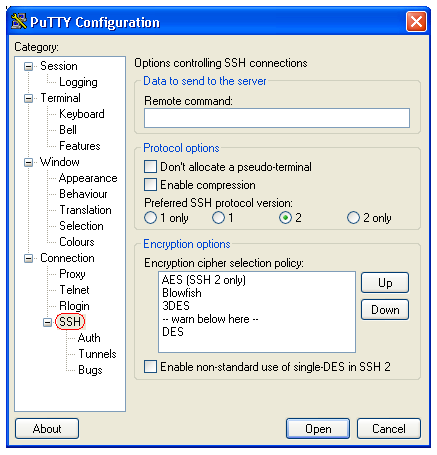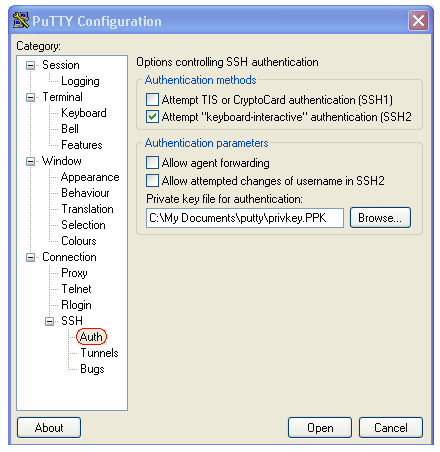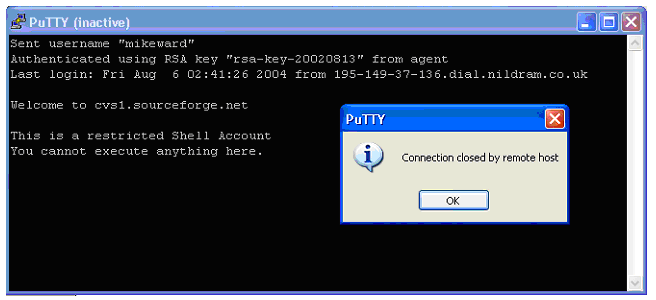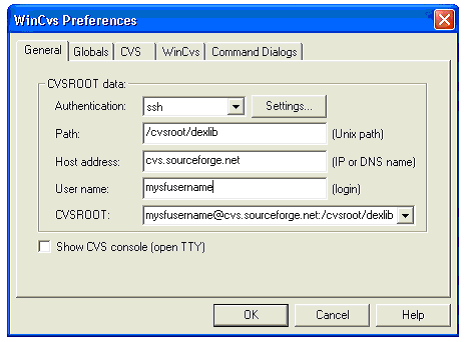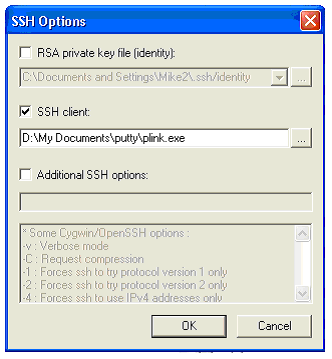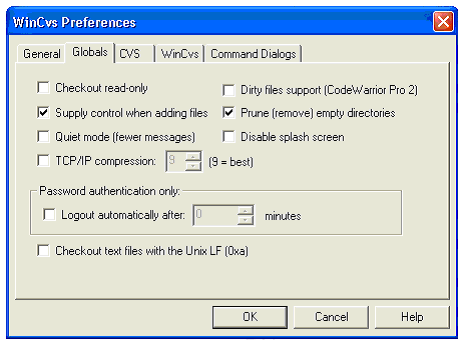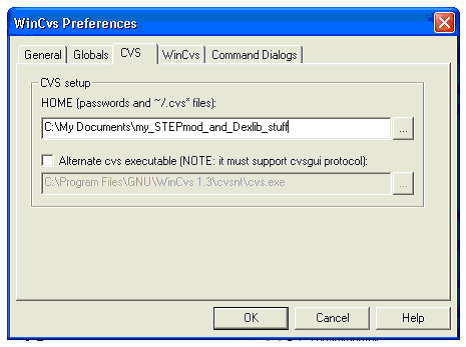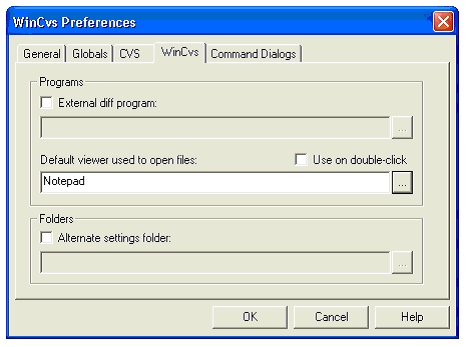| Help TOC > How to setup CVS for Sourceforge access
|
| How to setup CVS for Sourceforge access |
Date: 2008/02/26 10:41:48
Revision: 1.14
|
DEXlib and STEPmod are developed on Sourceforge.net. Sourceforge.net is a
free Open Source software and standards development website.
This page provides instructions about which actions should be performed in
order to gain access to DEXlib and STEPmod on Sourceforge.net. This is done
in two different ways depending on if you are a developer who needs to update
information, or if you are a non-developer who only wishes to download it.
Each file can also be accessed individually from the CVS section of DEXlib
and STEPmod without following the instructions below.
The guidence provided here is build from a number of preavious documents, but
the majority is extracted from a help guide created by Mike Ward, Eurostep. If
you encounter problems following this guide, contact anyone of the DEXlib
developers.
This section will explain the actions you need to take in order to be able to
download STEPmod or DEXlib for the purpose of viewing it only.
This section describes how CVS is set up to allow an user with developer status
to access DEXlib or STEPmod on Sourceforge.net.
- Go to, (https://sourceforge.net/account/register.php) and
follow the instructions given. You will be asked to choose a password and
enter a valid e-mail address, and then an account name, a display name, your
real name, your time-zone and then answer questions about optional e-mail
notifications.
- Keep a record of your chosen account name and password in a safe place.
-
Email Rob Bodington (rob.bodington(at)eurostep.com),
Tom Hendrix, (thomas.e.hendrix(at)boeing.com) or
Chris Kreiler (kreilerc(at)mantech-wva.com)
and request developer status.
Remember to include your SF.net account name and a reference to an
existing developer who may verify your request to join the team.
Figure 1 — An example e-mail.
- Wait for a confirmation.
- In order to create a safe connection to Sourceforge.net you need to download
some authentication software (a Telnet/SSH Client) named PuTTY. These files are required,
-
- PuTTY.exe - (a Telnet and SSH client)
- Plink.exe - (a command line interface to PuTTy)
- Pageant.exe - (an SSH autentication agent)
- PuTTYgen.exe - (an RSA and DSA key generation utility)
- These programs can all be downloaded from,
(http://www.chiark.greenend.org.uk/~sgtatham/putty/)
Look in the 'Download' section and chose files depending on your environment.
- Save the files on your HD in a new folder, e.g. 'putty'.
- Run 'PuTTYgen.exe' from the folder where you saved it, e.g. by double-clicking it.
Figure 2 — The PuTTYgen application.
- Make sure that 'SSH2RSA' is chosen in the Parameters section of the window that has
opened up.
- Click the 'Generate button'.
-
- type in your preferred password in "Key passphrase" field.
- retype your preferred password in "Confirm passphrase" field.
- keep a record of your password.
- save the private key as, e.g. 'priv_key' in your PuTTY-folder.
- save the public key as, e.g. 'pub_key' in your PuTTY-folder.
- Note that the chosen password is a local password on your own machine
that allows you access to your keys.
- Close the 'PuTTYgen' application.
- Visit, (http://sourceforge.net/account/) and log in to your
personal account, using your Sourcforge.net account name and password.
- Click on the [Account Options] link in the top menu to access the
'Account Maintenance' page.
- Scroll down and click on the link [Edit SSH Keys for Shell/CVS].
- Open the private key file (created in step 4) with the Puttygen application.
You will be asked for the password you chose.
- Copy the numerals in the 'Public key for pasting into OpenSSH authorized_keys file' box,
by selecting them with your mouse and press Ctrl+C.
- Paste the line into the 'Authorized keys:' box on the page at the SF website,
which loaded when you clicked on the [Edit SSH Keys for Shell/CVS] link.
- Click on the 'Update' button to add the key. You will be sent back to the 'Account
Maintenance' page.
- Wait for the key to be synchronized to the project.
There is up to a 10 minute delay between the time SSH keys are uploaded on the
SourceForge.net site until they are synchronized to the project shell and CVS servers.
If you again click on the link [Edit SSH Keys for Shell/CVS] you can check if
your copied string contains any errors (shown by red text). The key string
should not be broken into several lines!
You will have to complete the actions described in this step every time you use WinCVS.
These steps are also included in the guide on how to download,
work with, and upload DEXlib and STEPmod on Sourceforge.net
- Run 'pageant.exe'. An icon (a computer with a hat...) will appear in your
lower toolbar. No dialogue box will appear on your screen, only the icon.
- Double click on this icon.
Figure 3 — The Pageant application.
- Click on the 'Add Key' button.
- Browse to the folder where you saved your key pair, select your private key (file ends
with .PPK) and click on the 'Open' button.
- Type in the password you chose in step 4, and click on the 'OK' button. Your key should
appear in the Pageant window.
- Close the Pageant window. Note that the icon still is on your toolbar and the program
active. If you right-click on the icon and chose 'Exit' from the pop-up menu, the
Pageant application will close and you will not be able to log into DEXlib or STEPmod
with WinCVS.
- Run 'putty.exe' from your PuTTY folder. The PuTTY Configuration window should appear
on your screen.
Figure 4 — The PuTTY Configuration window and the 'Session' section.
- Open the 'Session' section if it's not already open.
- Type "cvs.sourceforge.net" in the 'Host Name (or IP address)' field.
- Type "22" in the 'Port' field (if necessary).
- Select "SSH" (if necessary) in the 'Protocol:' dialogue.
- Type a name for your PuTTY session in the 'Saved Sessions' field, e.g.
"my_putty_session".
- Check "Never" in the 'Close window on exit:' dialogue.
- Save your PuTTY session.
- Close PuTTY by clicking on the 'Cancel' button.
- Run 'putty.exe' again and load your created session ("my_putty_session").
- Open the 'Session' section again and save the changes you've made to your PuTTY session.
- Close PuTTY by clicking on the 'Cancel' button.
- The last step is to test the PuTTY connection.
This setup and test only needs to be performed once.
Though, if you later on experience authentication problems,
it could be a good idea to run this test again.
WinCVS is a graphical front-end for CVS (Concurrent Versions System).
CVS is an open-source version control system mainly used be software developers.
The instructions in step 9 below are written for version 1.3.13.2 of WinCVS.
The first three bullets describe how to download the most recent version of WinCVS.
If you wish to use the older 1.3.13.2 version, you can download it from here,
and skip these first three bullets.
- Use your web browser to visit [http://www.wincvs.org/], and scroll down to the 'CvsGui
distribution' section.
- Click on the [binaries and source code] link, and scroll down to the 'Latest Recommended
Release: WinCvs 1.3.20.3 (released 2004-11-21)' section. If the release numbers and dates
are different doesn't matter.
- Click on the [Download installer] link, chose a download location by clicking on the
download icon. Save the zip-file to your hard drive.
- Extract the 'setup.exe' file from the 'WinCvs13b20-3.zip' file into the same folder. The
zip file may have another name depending on which version was the most recent when you
performed the download.
- Run the 'setup.exe' file and accept the default settings. Also accept to install CVSNT.
WinCVS should now be installed on your computer, and an icon (a yellow fish) should be
present on your desktop.
These instructions for are valid for WinCvs 1.3.13.2.
- Create a folder for all your STEPmod and DEXlib files. Note that the main folders "StepMod"
and "Dexlib" must both be placed on the same level in the catalog hierarchy.
- Start WinCVS.
- Open the 'Admin' menu and select 'Preferences...' (or use Ctrl+F1).
- Click on the 'General' tab to set general preferences.
Figure 9 — The 'General' preferences tab in WinCVS.
- Select "ssh" in the 'Authentication' field.
- Type "/cvsroot/dexlib" in the 'Path:' field.
- Type "cvs.sourceforge.net" in the 'Host address:' field,
or the name of your PuTTY sessesion, e.g. 'my_putty_session'.
- Type your SourceForge user name, e.g. 'my_sf_username'' in the 'User name:' field.
- Click on the 'Settings...' button next to the 'Authentication' field.
Figure 10 — The 'SSH Options' window.
- Check the 'SH client:' box.
- Click on the '...' button next to the SSH text input field.
- Browse to your "plink.exe" file, select it and click on the 'open' button.
- Click on the 'OK' button in the 'SSH Options' window.
- Click on the 'CVS' tab to specify folder preferences.
Figure 12 — The 'Globals' preferences tab in WinCVS.
- Click on the '...' button next to the 'HOME' text input field.
- Browse to your STEPmod and DEXlib folder that you created in the beginning of this step,
select it and click on the 'open' button.
- Click on the 'WinCvs' tab to specify the file editor to be used.
Figure 13 — The 'WinCvs' preferences tab in WinCVS.
- Click on the '...' button next to the 'Default viewer used to open
files:' text input field.
- Browse to the file editor you wish to use when working in STEPmod or
DEXlib, select it and click on the 'open' button.
- Click on the 'OK' button in the 'WinCvs' preferences tab to save your settings
and exit the 'WinCvs Preferences' dialog.
Your computer should now be correctly set up to allow you to access STEPmod and DEXlib.
If you encounter problems or would like to suggest improvements to this guide, please
contact any of the DEXlib developers listed on Sourceforge.net. A guide on how to
work (download, edit, upload) with STEPmod and DEXlib is found
here.
Help TOC > How to setup CVS for Sourceforge access
No further subsections:
